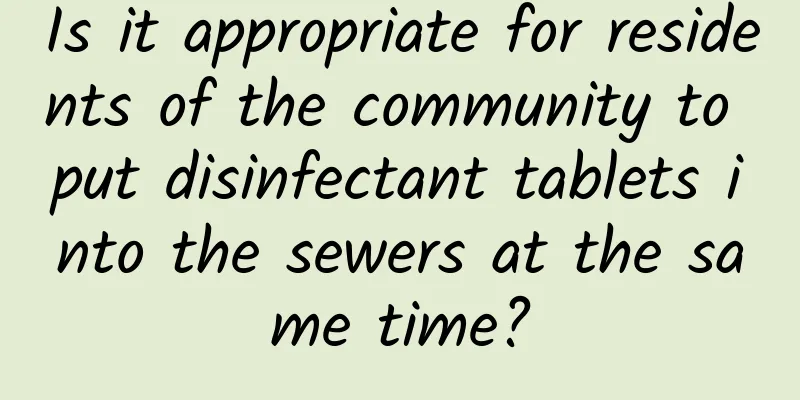Is it appropriate for residents of the community to put disinfectant tablets into the sewers at the same time?

|
Recently, a piece of news spread on the Internet. The general idea is that in order to prevent the epidemic, a neighborhood committee in a certain place distributed chlorine dioxide disinfection tablets to residents and required residents to put the tablets into the sewer pipes at home at the same time. This news has caused quite a bit of discussion online. Some say it will cause poisoning, some say it will produce carcinogens, and some say there is nothing wrong with doing this. So, does this have any disinfecting effect? Is it safe for residents? In general, are there any differences between the various disinfectants we have come into contact with since the outbreak? Chlorine dioxide is safe in itself, but it should still be used with caution Chlorine dioxide, because it has the word "chlorine" in its name, people may think it is related to chlorine gas and must be very toxic. In fact, it is not. Some chlorine-containing substances are highly oxidizing and can inactivate viruses or bacteria and eventually kill them, so they are often used in disinfectants. Representative disinfectants are the protagonists of this article, chlorine dioxide, and 84 disinfectant (the active ingredients are hypochlorous acid and hypochlorite). You don’t have to worry too much about the safety of chlorine dioxide. The reason why we fear chlorine gas is that it is poisonous because it is a suffocating gas. When inhaled, people will have difficulty breathing, coughing, and lung damage. Chlorine dioxide has a similar effect on the human body, but the effect is not as extreme as chlorine gas. In addition, the tap water we drink is usually disinfected with chlorine dioxide. Therefore, chlorine dioxide itself is relatively safe. However, it is not appropriate to arrange for residents to release it at the same time. Excessive production of chlorine dioxide Judging from the pictures circulating on the Internet, the chlorine dioxide disinfectant tablets used are a type of preparation similar to effervescent tablets. Usually, its main components are chlorite and citric acid, which are not easy to react under solid conditions; after contacting water, the disinfection tablets disintegrate, and chlorite forms a large amount of chlorine dioxide under acidic conditions. Most of this chlorine dioxide will dissolve in water, and a small part will evaporate slowly, so that it can be disinfected very efficiently and relatively safely. Chlorine dioxide aqueous solution | wikimedia commons/Iridos However, if many people use it at the same time, and it is possible that some people put multiple disinfection tablets at a time for more thorough disinfection, a large amount of chlorine dioxide will suddenly be produced in the sewer. This chlorine dioxide may no longer evaporate into the air in the form of slowly releasing it from the water, but instead emit excessive amounts of strong oxidizing gas in a short period of time. At this time, the relatively mild chlorine dioxide becomes a source of risk. If you are unlucky enough to encounter a toilet cleaner In addition, there is another risk that cannot be ruled out when using chlorine dioxide disinfectant tablets in sewers: what if someone happens to use toilet cleaner! The active ingredient in toilet cleaner is hydrochloric acid. When hydrochloric acid comes into contact with chlorite, it will not only produce chlorine dioxide, but also highly toxic chlorine gas. Therefore, although theoretically, the actual danger of using chlorine dioxide disinfection tablets in water can be ignored as long as the method is appropriate and the concentration is appropriate, the actual risk still exists due to the collective use of a large number of disinfection tablets in the sewer at the same time and the lack of organized coordination. Such activities are best carried out by professional institutions in a quantitative manner according to the actual treatment scale, which not only ensures the disinfection effect but also avoids some unnecessary troubles. Highly effective and destructive 84 disinfectant Let’s take a look at 84 disinfectant, which is similar to chlorine dioxide. Because 84 disinfectant contains chloride, its disinfection principle is similar to that of chlorine dioxide. Because it is highly oxidizing, it also has a bleaching effect丨A promotional page for a certain 84 disinfectant These disinfectants need to be diluted before use. When diluting, be sure to pay attention to the concentration (effective chlorine content). For general household disinfection, you can refer to the instructions for use of the disinfectant to wipe or soak related items. Hypochlorous acid is unstable and easy to decompose. When using 84, pay attention to the expiration date; if you use disinfectant tablets mixed with water, remember to "prepare before use". 84 disinfectants are highly irritating. When using them, be sure to follow the instructions and pay attention to ventilation. Do not let them get into the eyes or contact mucous membranes. Another side effect is that they produce chlorine atoms, which can cause long-term corrosion if used on some metal materials. Some devices involving circuits, such as the shells of mobile phones and computers, need to be used with caution. Also, it must be noted that 84 disinfectant, like chlorine dioxide, cannot be used with toilet cleaners. They will react chemically to produce chlorine gas, which will not only render the disinfection ineffective, but the toxicity of chlorine gas will also cause harm to the body. Medical alcohol is the most commonly used and can be used in general situations Medical alcohol specifically refers to alcohol with a concentration of 75%. Alcohol can denature proteins, so it has the effect of killing microorganisms. However, low-concentration alcohol has a poor killing effect, and high-concentration alcohol will cause the proteins on the surface of microorganisms to coagulate too quickly, and the alcohol cannot penetrate into them, resulting in poor effect. Actual research has found that alcohol with a concentration of around 75% has a strong killing effect. Bacteria and viruses are two different types of organisms. Medical alcohol has a strong killing effect on bacteria, but not necessarily on viruses, and is even ineffective against many viruses. The new coronavirus can be killed by alcohol because it has a protein envelope. Hand sanitizer and "antibacterial hand sanitizer" Washing hands frequently with hand sanitizer or soap and washing hands with running water for more than 20 seconds can help block the spread of the virus and can be used in combination with other protective measures. Among all hand-washing products, hand sanitizers containing "fungicides" are particularly popular. However, like medical alcohol, the fungicide in hand sanitizers may not be effective against viruses. Common hand sanitizers generally use two types of bactericides (or antibacterial agents). One is chlorine-containing phenols, the representative substance is para-chlorometaxylenol (PCMX); the other is quaternary ammonium salts, the representative substance is benzalkonium chloride (BAC). In some scientific tests, PCMX and BAC can kill some viruses, such as the common influenza virus. However, the concentrations used in the experiments are often high, and the killing effect is closely related to the type of virus. For example, for another common virus, HIV, these fungicides are just for fun. The active ingredients of hand sanitizers and hand disinfection products are quite diverse, some are alcohol, some are cetrimonium chloride, hypochlorous acid, etc. They can be used as an alternative when it is inconvenient to wash hands with running water and soap, and when the hands are not obviously dirty. Peracetic acid is cost-effective but has poor stability During the SARS epidemic in 2003, many people heard about the reputation of peracetic acid, and it became the main force in disinfecting public places. Peracetic acid has a strong oxidizing property. Normally, peracetic acid only needs to be prepared into an aqueous solution with a concentration of about 0.005% to be used for disinfection, and it can kill almost all viruses within one minute, with high efficiency. However, peracetic acid also has a significant disadvantage, that is, it is less stable and easily decomposes. As a dangerous product, it is difficult to buy peracetic acid directly on the market, and for most people, it is not realistic to prepare peracetic acid solution. Peracetic acid is also somewhat corrosive, so be sure to use it safely. However, it will not have a significant impact on various equipment in life. Physical disinfection methods need to consider the occasion Generally speaking, there are two ways to physically disinfect viruses: one is to use light, usually ultraviolet light; the other is to use heat. Most viruses are sensitive to ultraviolet light and high temperatures. Relatively speaking, high-temperature disinfection is easier to operate in a home environment. For example, some items can be boiled in hot water and clothes can be washed at the highest temperature indicated on the label. The symbol in the circle indicates that the maximum washing temperature is 40°C丨Li Xiaokui Ultraviolet light is a simple disinfection method. In the laboratory, you usually only need to turn on the ultraviolet lamp to disinfect the work surface. However, current household ultraviolet lamp equipment is usually not designed for disinfection, and the wavelength of ultraviolet light they emit may not be suitable for disinfecting viruses. In addition, UV light has serious side effects. It produces many toxic and harmful substances such as ozone, and may directly cause human harm (photoelectric eye inflammation and dermatitis will occur after 20 minutes of exposure). Therefore, it is not recommended to use UV light as a method of household disinfection. Guokr In addition to the common disinfection methods mentioned above, there are many other substances or methods that are often used to disinfect viruses. However, since these substances are often dangerous goods, such as ether, which is flammable and explosive, and chloroform, which can easily produce highly toxic phosgene that can cause death when not properly stored, they are difficult to purchase and are not recommended for non-professionals to operate. Author: Sun Yafei Editors: Luna, Dai Tianyi, Li Xiaokui This article comes from Guokr and may not be reproduced without permission. If necessary, please contact [email protected] |
<<: How to understand a famous book?
>>: Sun Jiadong, Lu Yuanjiu...their names shine in the starry sky
Recommend
How to operate WeChat e-commerce mini program? How to operate a mini program well?
After the mini program won the recognition of var...
Independent auto brands are gradually rising, but parts are still the fatal weakness of China's auto industry
At present, the market share of domestic automobi...
He is a master of astrophysics, but also a stumbling block to the development of the discipline?
Arthur Eddington made outstanding contributions i...
How to plan a complete and efficient event? (Four)
This article mainly discusses how to do a complet...
The latest movie ticket project in 2021, triple explosive gameplay helps you earn more than 100,000 yuan a month
Dongguan SEO Feng Chao recommends the Internet en...
Be careful when shopping online! Here is a guide to preventing fraud on Double Eleven online shopping!
The annual Double Eleven is here again! Have you ...
Information flow of Internet promotion channels!
Our marketing channels are located where there ar...
Computers are racing: Millions of CPUs are fighting in clusters! Powerful supercomputers...
Produced by: Science Popularization China Author:...
Tencent Advertising Marketing Optimization Strategy
Please explain in detail what kind of promotional...
If your breasts sweat during exercise, maybe you are wearing the wrong sports bra? The answer is not what you think...
Compiled by: Gong Zixin A few days ago A friend t...
Noodles are increasingly being demonized! Can eating noodles really make you fat?
According to the Buenos Aires Economic News Netwo...
[Recommended blog post] Real-time rendering of seawater on Unity3D mobile terminal
This blog post is from 51CTO blogger jxw167. If y...
Human foodies "catch strong men", female coconut crabs can't find a husband
"Don't get too fat, or people will eat y...
APP advertising: How to choose the right delivery channel?
If you don’t advertise, you’re waiting for death;...









